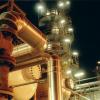I am new to this forum, find it really helpful for young engineers to find out solutions for their problems. I too have a problem, so I decided to write here after trying to get the answer through internet and books.
1. I have three solvents, ethanol, acetonitrile and heptane and these will be recovered from reactors of capacity 5kL, 3kL and 2kL with surface area of 2.7 m2, 1.9 m2 and 1.46m2 and Boiling points are 78C, 82C and 98C respectively. I need to recover maximum possible solvents under reduced pressure conditions of 100 mmhg absolute. But my problem is I am not able to find any formula to calculate the maximum vaporization rate of these solvents or any other way. It would be very helpful for me if somebody can tell me the way to calculate the maximum vaporization rate? Note: Temperatures above boiling point under reduced pressure can be used to increase the rate of vaporization.
2. Secondly, I need to calculate the condenser heat transfer area which will completely condense the vapors to liquid. Chilled water is available at 10 deg C. For Calculation of condenser heat transfer area, we will consider, liquid volume being vaporized or the vapor volume of solvent being vaporised.
3. How and where we use heat of vaporization? Is it also being used for calculating condenser surface area?
Please give your expert comments so that I can solve this.
Thanks
Vineet
Edited by vntgpt, 13 January 2011 - 12:02 AM.

 FB
FB











